急性酒精中毒完整版本
- 格式:ppt
- 大小:1.27 MB
- 文档页数:32
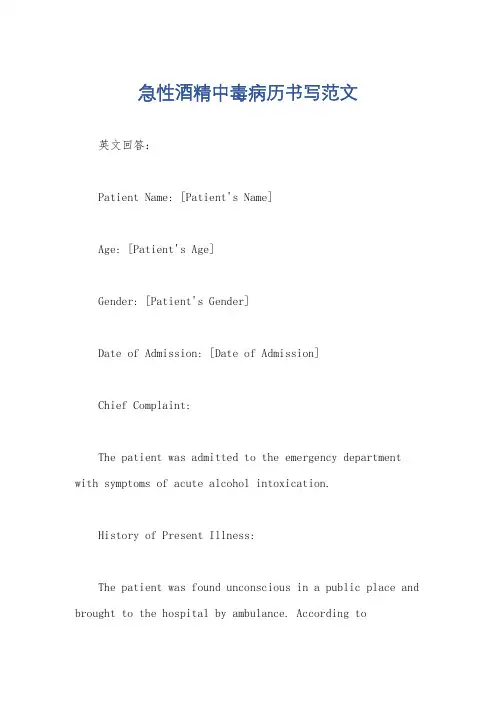
急性酒精中毒病历书写范文英文回答:Patient Name: [Patient's Name]Age: [Patient's Age]Gender: [Patient's Gender]Date of Admission: [Date of Admission]Chief Complaint:The patient was admitted to the emergency department with symptoms of acute alcohol intoxication.History of Present Illness:The patient was found unconscious in a public place and brought to the hospital by ambulance. According towitnesses, the patient had consumed a large amount ofalcohol within a short period of time. On arrival, the patient was unresponsive, had a strong odor of alcohol, and showed signs of respiratory depression.Medical History:The patient has a history of alcohol abuse and has been previously admitted to the hospital for alcohol-related issues.Physical Examination:Upon examination, the patient was found to have a decreased level of consciousness, with a Glasgow Coma Scale score of 8. The patient's vital signs were as follows:blood pressure 120/80 mmHg, heart rate 100 beats per minute, respiratory rate 12 breaths per minute, and oxygensaturation 95% on room air. The patient's breath had a strong smell of alcohol. The neurological examination revealed sluggish pupillary reaction and decreased deep tendon reflexes.Diagnostic Tests:Blood tests were performed, which revealed an elevated blood alcohol level of 0.25%. The patient's liver function tests were within normal limits. Other laboratory investigations, including complete blood count and electrolyte levels, were also within normal ranges.Treatment:The patient was immediately placed on a cardiac monitor and intravenous fluids were administered to maintain hydration. To enhance alcohol metabolism, thiamine andfolic acid supplements were given. The patient was also closely monitored for any signs of respiratory distress or aspiration.Outcome:Over the course of the next 24 hours, the patient's level of consciousness gradually improved, and the patientbecame responsive to verbal stimuli. The patient was transferred to the psychiatric department for further evaluation and management of alcohol dependence.中文回答:患者姓名,[患者姓名]年龄,[患者年龄]性别,[患者性别]入院日期,[入院日期]主诉:患者因急性酒精中毒症状被送至急诊科。

急性酒精中毒急救知识培训考核
姓名:得分:1.通常引起中毒症状的酒精饮用量约为()而致死量则为()左右。
( ) A.75-80g 500-1000g
B.100-150g 250-500g
C.75-80g 250-500g
D.50-100g 250-500g
E.10150g 300-600g
2.当血液中酒精含量达到150-250mg/dl时,患者可出现( )
A.言语不清及步调失调,复视、心动过速,嗜睡或情绪脆弱,伴突发发怒或违反社会的动作。
脑电β活动增加。
B.欣快或情绪紊乱,胆小或开朗,友好或好争辩,注意力不集中,判断力受损c.呼吸麻痹,可使50%的人致命。
D.木僵与多语、好斗交替,呼吸深、呕吐、脑电慢波化
E.昏迷
3.急性酒精中毒出现了动作失调、步态蹒跚、语无伦次、口齿不清,这是期的表现()
A.兴奋期
B.共济失调期
C.昏睡期
D.昏迷期
E.休克期
4.酒精能与以下哪种药物联合使用( )
A.头孢曲松
B.吗啡
C.苯巴比妥
D.青霉素
E.甲硝唑
5、对于急性酒精中毒引起的呼吸抑制,意识障碍最有效的药物是()
A.洛贝林
B.吗啡
C.肾上腺素
D.纳洛酮
E.多巴胺。
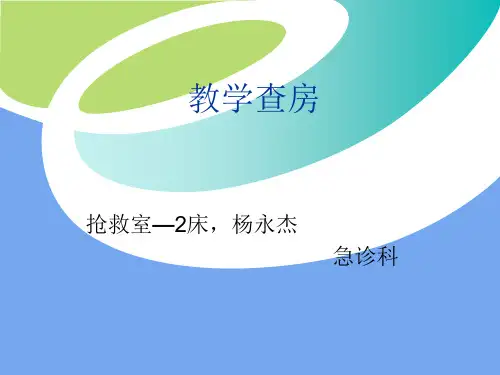
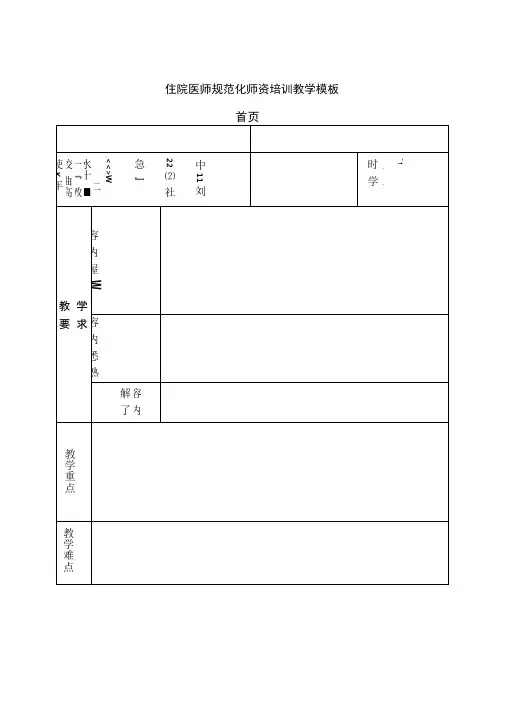
住院医师规范化师资培训教学模板
首页
教学方法:结合依托案例,以互动式与启发式教学方法相结合讲授。
教学手段:传统教学手段(模型模具、标本实物、各种摄片、化验单、心电图、与
挂图图示等)现代教学手段相结合。
1•急性酒精中毒的病因5分钟
2•急性酒精中毒的临床表现8分钟
3•急性酒精中毒的诊断要点及治疗10分钟
4.课堂讨论与小结5分钟
续页
第十章急性中毒
④应用葡萄糖溶液、维生素B1、维生素B6等,促进乙醇氧化为醋酸,达到解毒目的。
⑤血乙醇浓度〉5000mg/L伴有酸中毒或同时服用其他可疑药物者,应及早行血液透析或腹膜透析治疗。
2. 支持治疗
重在维护心、肺、肝、肾、脑等生命器官功能。
应用纳洛酮静脉注射,对昏迷患者有促醒作用。
对依托病例患者给予纳洛酮、葡萄糖醒酒对症处理后,患者渐清醒,未发生任何并发症。
【小结】
急性酒精中毒是指过量饮酒后引起以神经精神症状为主的急症。
有大量饮酒史,主要表现头
晕、头痛、呕吐、意识障碍、呼吸衰竭,排除其他引起意识障碍的疾病。
给予护脑,抑酸,补液、纳洛酮、葡萄糖醒酒对症处理。
〔复习题〕
1、简要叙述急性酒精中毒临床特点?
2、急性酒精中毒的诊断依据是什么?如何鉴别诊断?
3、简要叙述急性酒精中毒的治疗原则?。
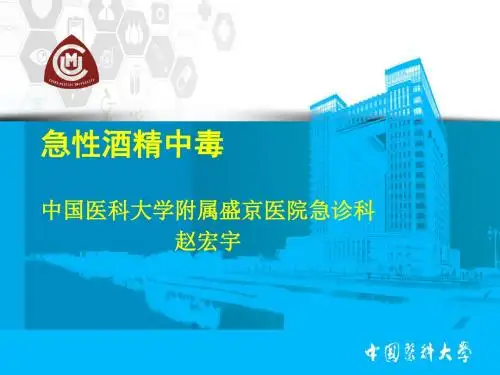

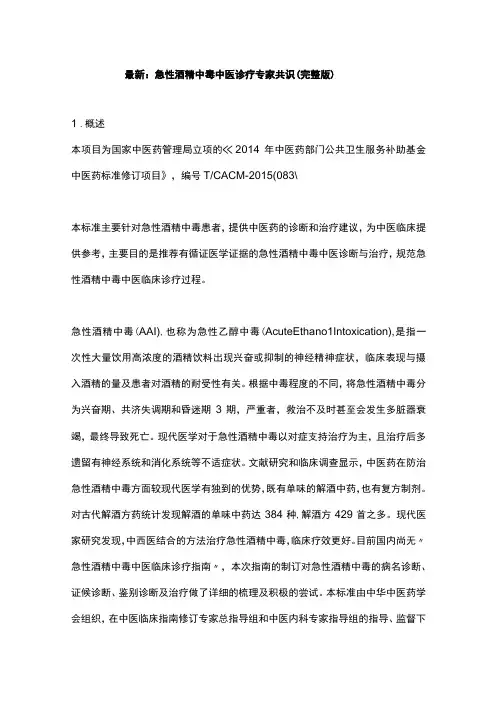
最新:急性酒精中毒中医诊疗专家共识(完整版)1 .概述本项目为国家中医药管理局立项的≪2014年中医药部门公共卫生服务补助基金中医药标准修订项目》,编号T/CACM-2015(083\本标准主要针对急性酒精中毒患者,提供中医药的诊断和治疗建议,为中医临床提供参考,主要目的是推荐有循证医学证据的急性酒精中毒中医诊断与治疗,规范急性酒精中毒中医临床诊疗过程。
急性酒精中毒(AAI),也称为急性乙醇中毒(AcuteEthano1Intoxication),是指一次性大量饮用高浓度的酒精饮料出现兴奋或抑制的神经精神症状,临床表现与摄入酒精的量及患者对酒精的耐受性有关。
根据中毒程度的不同,将急性酒精中毒分为兴奋期、共济失调期和昏迷期3期,严重者,救治不及时甚至会发生多脏器衰竭,最终导致死亡。
现代医学对于急性酒精中毒以对症支持治疗为主,且治疗后多遗留有神经系统和消化系统等不适症状。
文献研究和临床调查显示,中医药在防治急性酒精中毒方面较现代医学有独到的优势,既有单味的解酒中药,也有复方制剂。
对古代解酒方药统计发现解酒的单味中药达384种,解酒方429首之多。
现代医家研究发现,中西医结合的方法治疗急性酒精中毒,临床疗效更好。
目前国内尚无〃急性酒精中毒中医临床诊疗指南〃,本次指南的制订对急性酒精中毒的病名诊断、证候诊断、鉴别诊断及治疗做了详细的梳理及积极的尝试。
本标准由中华中医药学会组织,在中医临床指南修订专家总指导组和中医内科专家指导组的指导、监督下实施,文献评价小组确定筛选证据的标准,并通过检索数据库,筛选出符合纳入标准的文献共188篇,并进行文献质量评价及证据分级,根据证据分级达成专家共识,并提出推荐意见,初步制定出针对急性酒精中毒的中医临床诊疗指南。
本标准是根据中医对急性酒精中毒的临床研究成果并结合专家经验制定。
适用于18岁以上成人急性酒精中毒的诊治,为临床提供急性酒精中毒诊断、辨证、治疗、预防和调护的中医药指导方案。


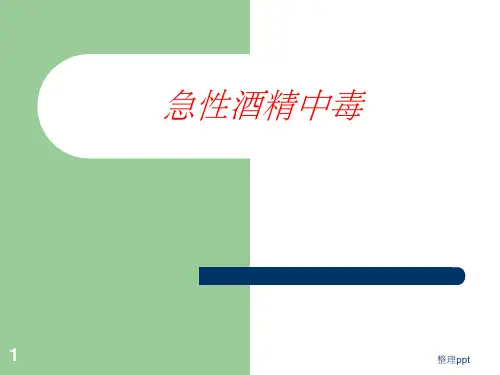
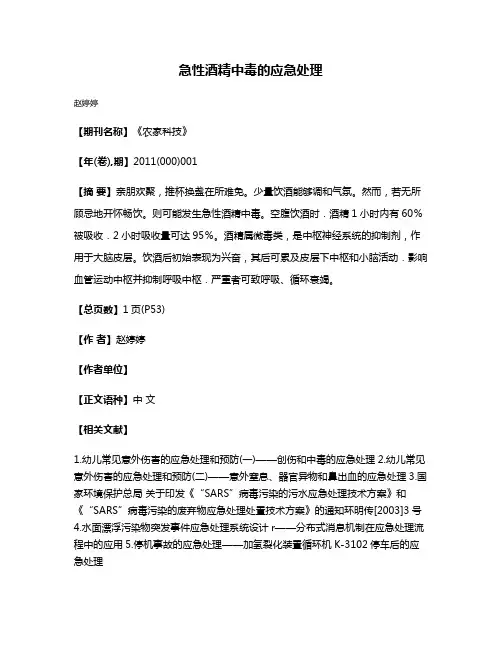
急性酒精中毒的应急处理
赵婷婷
【期刊名称】《农家科技》
【年(卷),期】2011(000)001
【摘要】亲朋欢聚,推杯换盏在所难免。
少量饮酒能够调和气氛。
然而,若无所顾忌地开怀畅饮。
则可能发生急性酒精中毒。
空腹饮酒时.酒精1小时内有60%被吸收.2小时吸收量可达95%。
酒精属微毒类,是中枢神经系统的抑制剂,作用于大脑皮层。
饮酒后初始表现为兴奋,其后可累及皮层下中枢和小脑活动.影响血管运动中枢并抑制呼吸中枢.严重者可致呼吸、循环衰竭。
【总页数】1页(P53)
【作者】赵婷婷
【作者单位】
【正文语种】中文
【相关文献】
1.幼儿常见意外伤害的应急处理和预防(一)——创伤和中毒的应急处理
2.幼儿常见意外伤害的应急处理和预防(二)——意外窒息、器官异物和鼻出血的应急处理
3.国家环境保护总局关于印发《“SARS”病毒污染的污水应急处理技术方案》和《“SARS”病毒污染的废弃物应急处理处置技术方案》的通知环明传[2003]3号
4.水面漂浮污染物突发事件应急处理系统设计r——分布式消息机制在应急处理流程中的应用
5.停机事故的应急处理——加氢裂化装置循环机K-3102停车后的应急处理
因版权原因,仅展示原文概要,查看原文内容请购买。